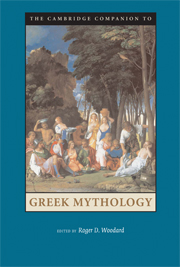Book contents
- Frontmatter
- Introduction: Muthoi in Continuity and Variation
- Part I Sources and Interpretations
- Part II Response, Integration, Representation
- 8 Greek Myth and Greek Religion
- 9 Myth and Greek Art: Creating a Visual Language
- 10 Mythic Landscapes of Greece
- 11 Politics and Greek Myth
- 12 Ovid and Greek Myth
- Part III Reception
- Bibliography
- Index
11 - Politics and Greek Myth
from Part II - Response, Integration, Representation
Published online by Cambridge University Press: 28 March 2009
- Frontmatter
- Introduction: Muthoi in Continuity and Variation
- Part I Sources and Interpretations
- Part II Response, Integration, Representation
- 8 Greek Myth and Greek Religion
- 9 Myth and Greek Art: Creating a Visual Language
- 10 Mythic Landscapes of Greece
- 11 Politics and Greek Myth
- 12 Ovid and Greek Myth
- Part III Reception
- Bibliography
- Index
Summary
Pausanias has long been essential reading for archaeology students and those interested in reconstructing the topography of ancient poleis. Yet - as anybody who has been frustrated by such infuriatingly vague directions as 'not far from' or 'a little further on' can testify - Pausanias is not overwhelmingly interested in offering his readers a detailed guided tour of sites to see. Rather, the monuments that are described are the repositories of local narratives, both factual and fictional, that constitute an important part of the cultural heritage of a Greece now enslaved to Rome. In the description of the Argive agora, for example, the reader is introduced in short order to the tomb where Danaus' daughter Hypermnestra and her husband Lynceus are buried (2.21.2), the tumulus where Perseus interred Medusa’s head (21.5) and the underground bronze chamber in which Acrisius incarcerated Danae (23.7). Each polis that Pausanias visits grounds its unique identity in the specific matrix of myths and memories that are conveyed through such visible monuments.
Myth was not, however, confined to affairs within the polis. From at least the fifth century, diplomatic relationships between poleis had been articulated through the vocabulary of kinship (syngeneia), often explained in terms of mythical connections between the two communities. Thus, at about the time when Pausanias was writing (probably in the 160s and 170s CE), an inscription was set up in the Argive agora celebrating the kinship between Argos and Cilician Aegeae and noting that it dated back to the time when Perseus, son of Danae, travelled to Cilicia in his hunt for the Gorgons.
- Type
- Chapter
- Information
- The Cambridge Companion to Greek Mythology , pp. 331 - 354Publisher: Cambridge University PressPrint publication year: 2007
- 5
- Cited by

